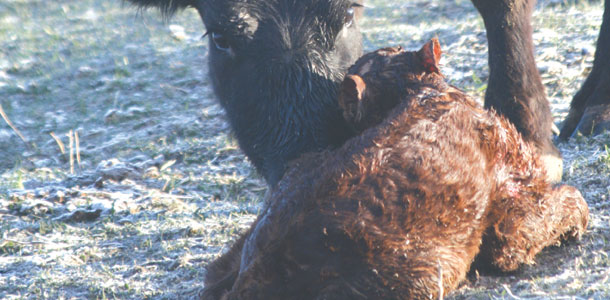The following guidelines highlight management impacts on development costs and performance.
Nutrition
- Target 60 percent of mature weight at the start of breeding season and a body condition of 5 to 6.
- A lighter target weight (53 to 58 percent) is appropriate when additional heifers can be exposed for breeding than are needed to maintain herd size and if selling open heifers at the end of the breeding season is profitable. Higher target weights (60 to 65 percent) are appropriate when used with an A.I. program and feed cost is less of a concern. Body condition scores of 7 or more are expensive to achieve and generally result in lower fertility.
- Determine needed gain from weaning until breeding season begins and develop ration appropriately. Usually 0.75 to 1.5 pounds per day gain will suffice.
- Monitor weight and body condition during development to achieve gain and condition goals.
- Use of an ionophore can conserve forage and improve reproductive response.
- Gains on summer pasture are inversely related to gains over winter.
- Regardless of target weight at breeding, heifers should continue to grow post-breeding and achieve a target of 85 percent of mature weight and a body condition of 5.5 to 6 at first calving.
- Experience grazing crop residue or winter pasture as heifer calves can be beneficial to future performance when nutrient demands are higher.
Health
- Consult with your local veterinarian for the optimum vaccination and parasite control program for your situation. In most cases, three injections of a MLV respiratory complex prior to breeding should be used.
- Two doses of vaccine for leptospirosis and vibriosis, 21 days apart with the final dose 30 days before breeding are recommended.
- Response to vaccination is improved in animals in moderate to good body condition and with adequate trace mineral status.
Reproduction
- Heifers should be gaining weight 60 days before and during the breeding season.
- Reproductive tract scores (1 = infantile to 5 = mature and cycling) taken 50 to 60 days prior to breeding can be used to assess physiological maturity. If 50 percent of heifers have tract scores of 3 or more 50-60 days prior to breeding, estrous synchronization programs are more successful.
- The postpartum interval to first estrus is longer in first-calf heifers than mature cows. Breeding heifers to calve two to three weeks ahead of the cow herd reduces the risk of reproductive failure at the second breeding season.
- Risk of calving difficulty is minimized when high-accuracy calving ease sires are used via A.I.
- Use a short breeding season, 30 to 45 days or less, to improve odds of re-breeding at second breeding and concentrate calving season labor.
- Change of diet resulting in short-term decreases in energy intake can be detrimental to embryo survival (drylot to pasture post-A.I.). Stress from a new environment, novel feedstuffs, as well as energy content of feedstuffs can contribute. If pasture growth is short, delayed or even extremely lush during the early breeding season, short-term supplementation may be warranted in heifers transitioning from a drylot.
- If heifers must be moved after A.I., then transportation should be within three to four days of breeding or after 42 days.
Other considerations

- A cross-bred heifer is expected to produce the equivalent of at least one more calf in weaning weight than a straight-bred heifer in a lifetime.
- Heifers born in the first 21 days of the calving season remain in the herd longer than those born in later cycles. Data show from 0.6 to 1.2 years longer.
- Heifers that conceive in the first 21 days of the first breeding period have heavier calves at weaning. In a recent study, the weight advantage was apparent through six calf crops.

—Excerpts from Kansas State University Research and Extension newsletter Beef Tips, January 2014
PHOTOS
PHOTO 1: If heifers must be moved after A.I., then transportation should be within three to four days of breeding or after 42 days.
PHOTO 2: A cross-bred heifer is expected to produce the equivalent of at least one more calf in weaning weight than a straight-bred heifer in a lifetime. Photos by Paul Marchant.
 Sandy Johnson
Sandy Johnson
Livestock Specialist
Kansas State University








